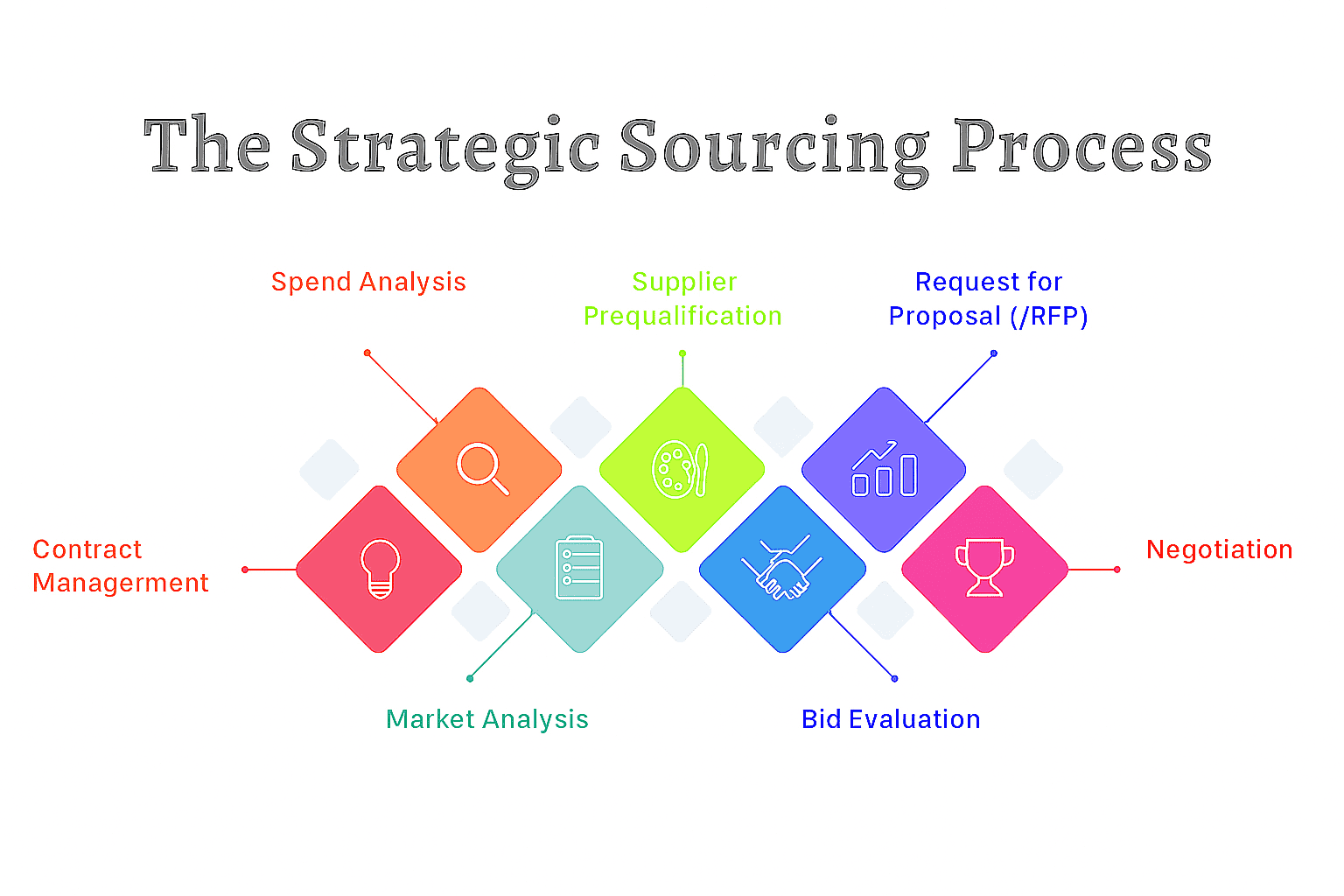Introduction
For manufacturers and industrial companies, supply chain costs often determine the difference between profit and loss. Strategic sourcing offers a proven path to unlock cost savings, reduce risk, and build a stronger, more resilient procurement process.
In this blog post, we'll explore tips on maximizing cost savings through strategic sourcing.
What is Strategic Sourcing?
Strategic sourcing is an analytical approach to procurement with an eye to identifying the critical products and services needed to run a business and then finding the suppliers who can provide these products or services at the best price, quality, and delivery.
It involves deeply analyzing needs for goods or services, recognizing a wider range of potential sources and suppliers, evaluating a variety of offers, negotiating contracts from a position of strength, and closely managing supplier performance.
The Strategic Sourcing Process

The strategic sourcing process can be complex and time-consuming, but it can lead to significant cost savings and operational efficiencies.
To make the process more tangible, let’s go through an example of a supplier analysis. When setting out to identify opportunities to improve their supply chain with new suppliers, a strategic sourcing manager should go through these processes:
- Spend Analysis: The first step in the process is to analyze the spend data to identify the categories of spend and the suppliers that the organization is currently using. This analysis will help identify areas of opportunity for cost reduction, consolidation, and supplier rationalization. If you capture Purchase Price Variance (PPV), that’s a great place to start – any inputs with a high PPV are great opportunities to reduce COGS.
- Market Analysis: The next step is to conduct a market analysis to understand the supplier landscape and the market trends. This analysis will help identify potential suppliers, their capabilities, and the competitive landscape. Many companies work off of a relatively small Approved Vendor List (AVL), which oftentimes means that they miss opportunities to work with suppliers that can offer components at a better price or with more reliability.
- Supplier Prequalification: Once potential suppliers have been identified, the next step is to prequalify them based on a set of criteria such as financial stability, quality, delivery, and environmental sustainability. This step will help narrow down the list of potential suppliers to a shortlist of qualified suppliers.
- Request for Proposal (RFP): The next step is to issue a request for proposal (RFP) to the shortlisted suppliers. The RFP should provide detailed information about the organization's requirements, evaluation criteria, and contract terms and conditions.
- Bid Evaluation: Once the RFP responses have been received, the next step is to evaluate the bids against the evaluation criteria. The evaluation criteria should be based on a weighted scorecard that takes into account the organization's priorities, such as price, quality, delivery, and supplier capabilities.
- Negotiation: After the bid evaluation, the next step is to negotiate with the selected suppliers to finalize the contract terms and conditions. This step involves identifying areas of potential cost savings and negotiating favorable terms and conditions for the organization.
- Contract Management: Once the contract has been awarded, the final step is to manage the supplier relationship and monitor their performance. This involves developing a supplier performance scorecard, setting up regular performance reviews, and ensuring that the supplier complies with the terms and conditions of the contract.
Key Tips to Maximize Cost Savings Through Strategic Sourcing

Effective strategic sourcing is about more than chasing the lowest price—it’s about using proven levers to drive measurable, lasting savings. Start with these key moves:
1. Volume Consolidation
Aggregate your demand across all business units and sites. This is the fastest way to negotiate better pricing and secure bulk discounts from suppliers. Consolidating volume also reduces your supplier count, simplifies administration, and strengthens your position at the negotiating table. For any organization with multiple buying points, volume consolidation is non-negotiable if you want real cost control.
By combining similar spending categories—such as electronic components, MRO supplies, or facility services—you strengthen your buying power and position your company for volume-based discounts.
2. Internal Redeployment
Before you look outside your company for new equipment or supplies, check what’s already available within your organization. Internal redeployment means moving underused or idle assets from one site or department to another where they’re needed most. This approach minimizes unnecessary purchases, shortens lead times, and maximizes the value of your existing investments.
By tracking surplus inventory and sharing visibility across all locations, you can match internal demand with available assets in real time. Internal redeployment saves on procurement costs, reduces excess inventory, and helps standardize equipment use company-wide.
Make internal redeployment a core part of your strategic sourcing plan. It’s one of the fastest ways to cut spending and boost operational efficiency—without adding complexity to your supply chain.
3. Alternative Sourcing Channels
Don’t limit your sourcing strategy to traditional suppliers. Use surplus, liquidation, and secondary markets to source categories like maintenance, repair, and operations supplies or electronics. These channels offer high-quality products at a fraction of the cost, help you secure hard-to-find parts, and reduce procurement lead times.
Building alternative channels into your strategy protects against shortages and delivers meaningful cost savings that conventional sourcing can’t match.
4. Category Management
Appoint dedicated category managers to oversee high-impact spend areas. These experts analyze usage patterns, develop tailored sourcing strategies, and negotiate directly with suppliers for each category.
Focused category management improves cost control, increases supplier accountability, and uncovers additional savings opportunities that generic, one-size-fits-all procurement approaches often miss.
5. Digital Procurement Tools
Deploy spend analytics and e-sourcing platforms to gain full visibility into your procurement activity. Digital tools help you pinpoint savings opportunities, monitor supplier performance, and enforce compliance across the organization.
With real-time data, you make informed decisions, reduce manual errors, and accelerate your strategic sourcing initiatives.
How Amplio Supports Strategic Sourcing Success
Broad Supplier Access
Amplio connects you to an extensive network of qualified suppliers, so you’re never limited to a handful of vendors. This expanded access helps you source hard-to-find components, control costs, and reduce risk during supply disruptions.
Real-Time Market Intelligence
Our platform delivers up-to-date pricing and availability insights across hundreds of suppliers. You can quickly benchmark options, compare costs, and spot savings opportunities as markets shift.
Instant Alternative Sourcing
When a shortage or price spike occurs, Amplio’s software identifies alternative suppliers instantly. This keeps your supply chain running smoothly and protects your margins by reducing the cost of goods sold.
Actionable Procurement Tools
We give you powerful search, analytics, and supplier-matching capabilities. These tools enable your procurement team to act fast, negotiate confidently, and make informed decisions with every purchase.
Expert Support—Every Step of the Way
Amplio works as your sourcing partner. Our team helps you unlock new cost-saving channels, optimize your supplier mix, and streamline your procurement process for long-term success.






